Menus
- A twin-twin situation
- On the ache with the Triumph Bonneville and the Yamaha TX 750
- Parallel twin: yes – vibrations: no
- Yamaha TX is more of an elegant lady than a rocker bride
- The 750 conveys twin feeling and driving pleasure
- The name Bonneville has a record-breaking history
- There are no losers, only winners
- In detail: Triumph Bonneville 750
- Facts
- Used check
- market
- In detail: Yamaha TX 750
- Used check
- market
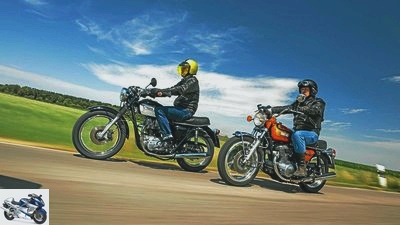
www.
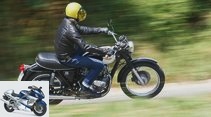

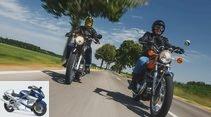

40 photos
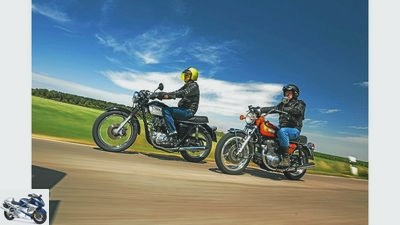
, archive
1/40
When comparing the British original Triumph Bonneville 750 with the Japanese answer, the Yamaha TX 750, there are no losers, only winners.

, archive
2/40
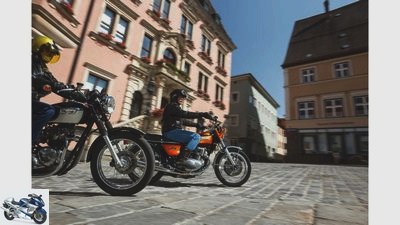
, archive
3/40
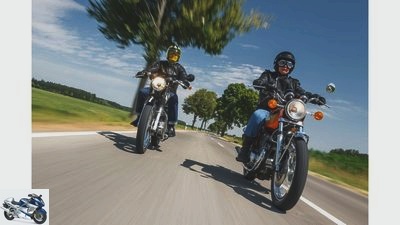
, archive
4/40
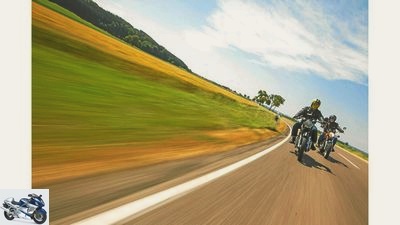
, archive
5/40
You want to indulge in your daydreams, animated by the rumbling twin sound, and cruise endlessly across the country.

, archive
6/40
Gerhard Eirich, editor, on the Triumph Bonneville 750: The Triumph reveals itself to be an honest representative of the old school twins – robust, powerful and active to drive.

, archive
7/40
Gerhard Hoss, owner of the Yamaha TX 750: Clearly, for me the TX 750 is the most beautiful bike of its era.

, archive
8/40
Thanks to Triumph specialist Dietmar Beck for the support. In his shop in the west of Stuttgart (www.trumpet-classics.de), Tel .: 01 63/164 47 49, Triumph owners not only find classic clothes and loads of items, but also advice and assistance with technical problems.
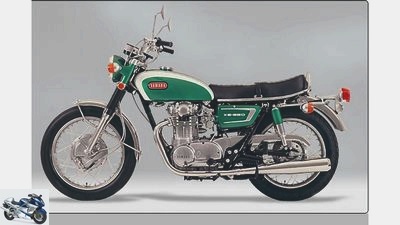
, archive
9/40
1969 to 1972: The 650, known as the XS-1, was initially only offered in the USA, the XS-2 from 1971 also in Europe. The XS 650 B followed in August 1974. Price: 5295 marks (1972).
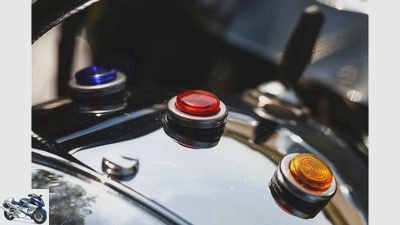
, archive
10/40
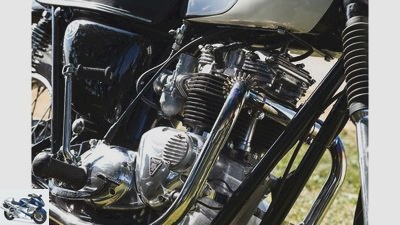
, archive
11/40
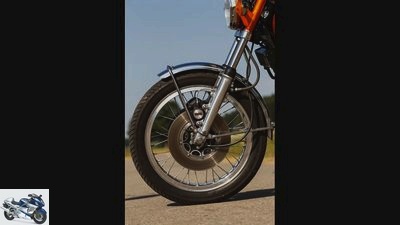
, archive
12/40
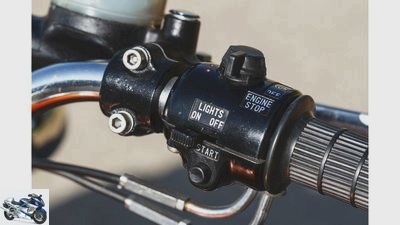
, archive
13/40
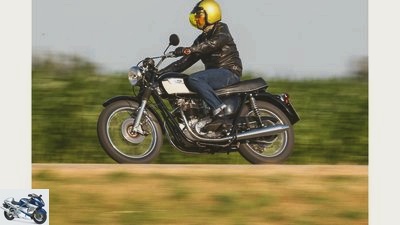
, archive
14/40
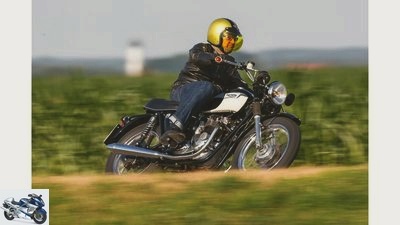
, archive
15/40

, archive
16/40
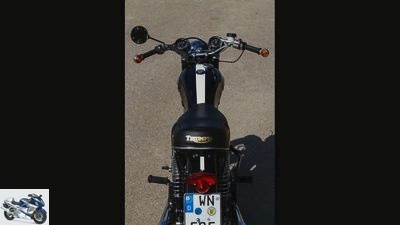
, archive
17/40
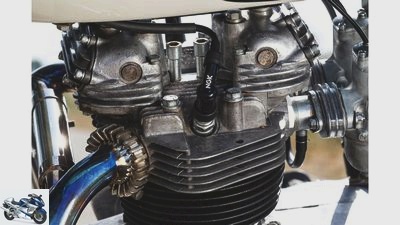
, archive
18/40

, archive
19/40
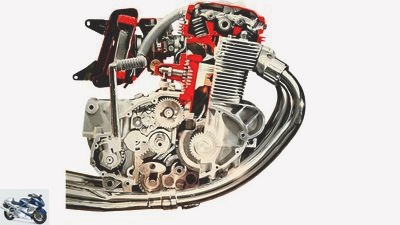
, archive
20/40
Insight into the TX innards with the two balance shafts (at the bottom).
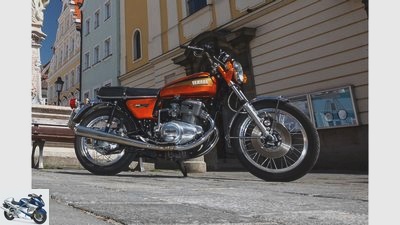
, archive
21/40
The Yamaha TX 750.
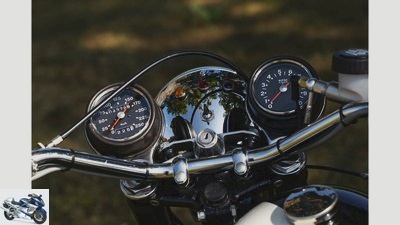
, archive
22/40
Let there be light – there’s the little toggle switch on the headlight.
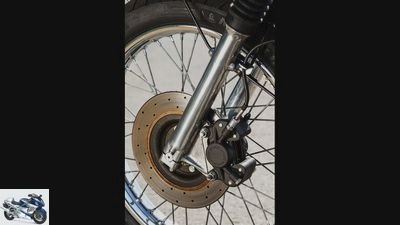
, archive
23/40
The 254 mm disc with two-piston caliper is used at the front and rear.
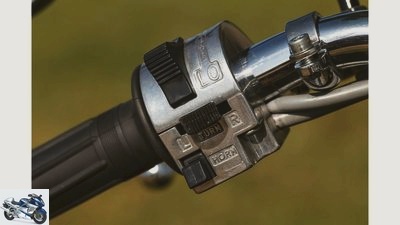
, archive
24/40
No black plastic monotony – the switch unit has style.
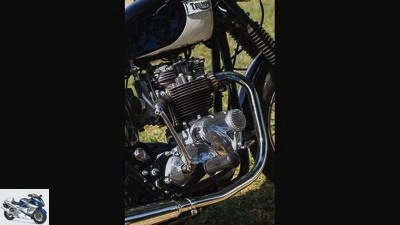
, archive
25/40
A picture of a twin: an air-cooled two-cylinder could hardly be styled more classically than the strikingly shaped Triumph 750.
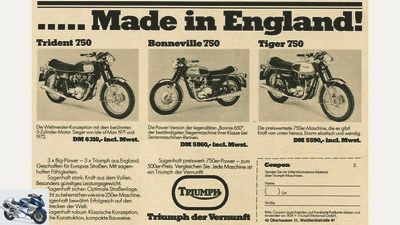
, archive
26/40
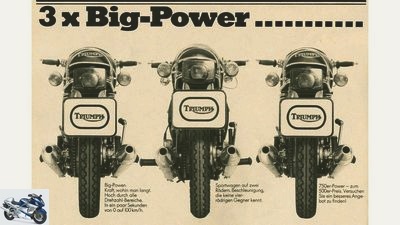
, archive
27/40
… Advertising printed in black and white. “Big Power” here means 49 hp.

, archive
28/40
Now and then: Bonneville, leaning against the tree in black and chrome …
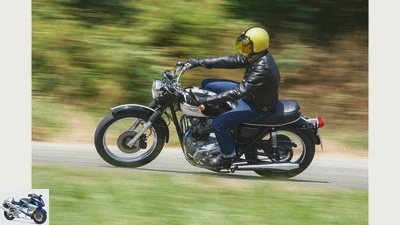
, archive
29/40
Quickly around the corner in the manner of a gentleman: The Triumph allows a brisk driving style.
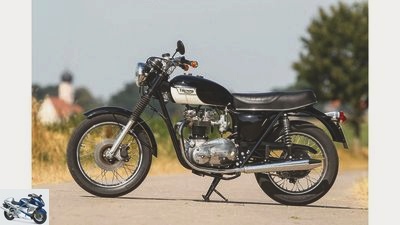
, archive
30/40
The Triumph Bonneville 750.
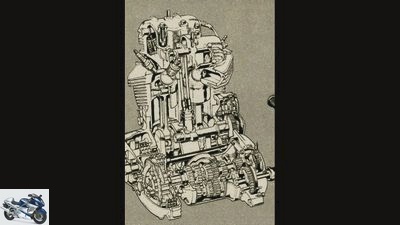
, archive
31/40
The unit construction version replaced the “pre-unit” in 1963 – the motor and gearbox are no longer separate, but combined in a common housing.
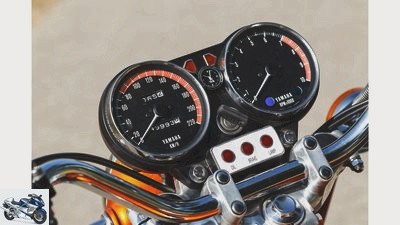
, archive
32/40
Pioneer: cockpit with red warning lights for oil pressure, brake pad wear and rear light function.
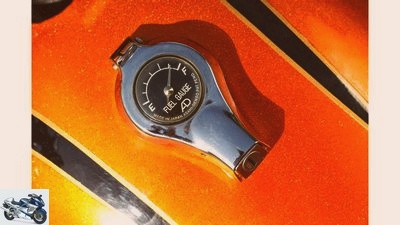
, archive
33/40
A rare accessory: the gas cap with fuel gauge from Asahi-Denso.
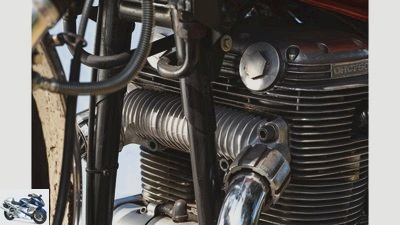
, archive
34/40
Heat nest: The interference tube between the manifolds causes problems.
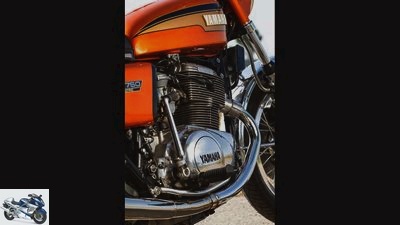
, archive
35/40
The short-stroke designed ohc motor of the Yamaha appears almost plain and inconspicuous with its even ribbing.
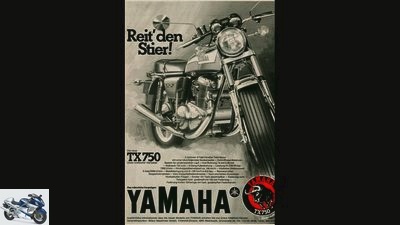
, archive
36/40
… even if the advertising of yore suggests something else. The ride on the TX is definitely worth it.
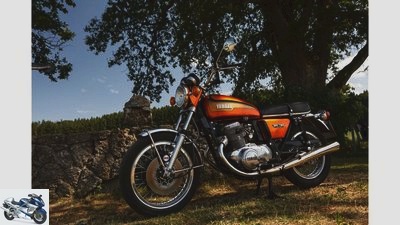
, archive
37/40
More like a golden calf than a (wild) bull, …
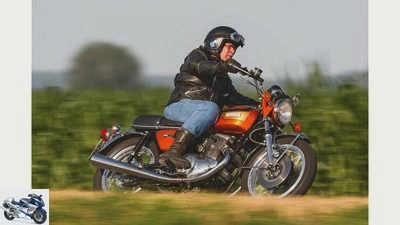
, archive
38/40
Sit relaxed, drive sporty – the handling of the 240-kilogram TX is astonishing.
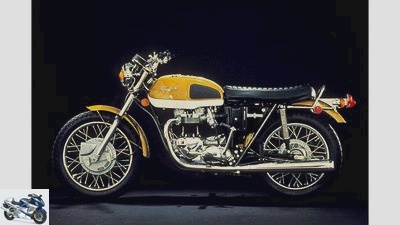
, archive
39/40
1959 to 1975: The Bonneville 650 was presented as the T120 model in London at the end of 1958. For many fans she is still considered the most beautiful Bonnie.
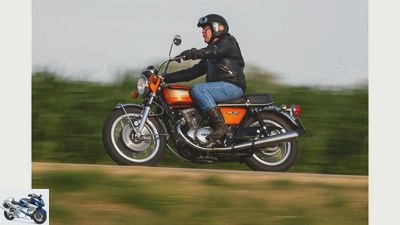
, archive
40/40
On the move: Triumph Bonneville and Yamaha TX 750
A twin-twin situation
Content of
When comparing the British original Triumph Bonneville 750 with the Japanese answer, the Yamaha TX 750, there are no losers, only winners. Both offer great seventies styling and a real driving experience with high-capacity parallel twins. However, there are also clear differences.
On the ache with the Triumph Bonneville and the Yamaha TX 750
D.The British are crazy. That would be a perfect start to this article in the most beautiful Asterix manner. And one is generally never really wrong with this statement, the island Europeans are at least a bit headstrong, they still drive on the wrong side of the road today and the aged English vehicles demand customs tools.
Buy complete article
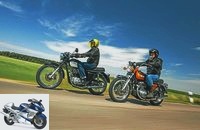
On the move: Triumph Bonneville and Yamaha TX 750
A twin-twin situation
The "better Bonneville" from Japan?
The (slightly modified) old hit rushes into my ear and can hardly be switched off – “My Bonnie from over the ocean” trills my inner jukebox. A triumph from overseas. But can such a Japanese ever exude British flair or even that driving feeling? And does she even want to be a better copy of the British original? At least one in Japan opted for the parallel twin. A runner-up, but if you please without the coarse expressions of life of triumph, but with the running culture of a (now also considered) four-cylinder – according to the motto “wash me, but don’t get me wet”. There should not be a lack of comfort, and the bad habit of the British Twins to stamp and pound like that, they wanted to pull the new one on the drawing board.
The fact that the TX 750 has been given a short-stroke bore / stroke ratio may seem strange if you are looking for a full blow and powerful pulling power, but so be it. The fact that the Yamaha can be started comfortably at the push of a button using an electric starter may also be acceptable. You wanted a little luxury. But did the two chain-driven, counter-rotating balance shafts have to be, which are supposed to eliminate the first-order inertial forces and the associated vibrations, which largely account for the robust character of the English Twins? And has the trick at least been successful, does the Yamaha really run that vibration-free? Time to start the machines and get to the bottom of things.
Parallel twin: yes – vibrations: no
, archive
Quickly around the corner in the manner of a gentleman: The Triumph allows a brisk driving style.
TX owner Gerhard Hoss, in front of whose garage in the beautiful Allgau we have already unloaded the Triumph we brought with us, pushes his well-preserved 1974 gem into the starting position. Almost two years ago he added the Twin to his Yamaha-heavy collection (including the RD 350, XS 850, XS 1100) and restored it to perfect condition by means of a meticulous restoration (the engine has so far remained untouched). So fully open the choke lever on the left side of the two 28 millimeter vacuum carburettors from Mikuni, do not accelerate and press the button. The powerful 16 Ah battery has enough reserves should the first attempt fail. But the twin comes to life, hums sonorous with increased idle speed and wishes to be left alone until after a short warm-up phase it takes on the gas. In fact, there is a typical, if strongly muffled twin sound, but no trace of pounding or shaking. The construct called “Omni-Phase-Balancer-System” by Yamaha seems to do its job perfectly. That wasn’t always the case at the beginning, the first models suffered from problems with elongated timing chains, the resulting vibrations, even broken chains and major engine damage. Yamaha responded and, as part of the revision, offset the rear balancer shaft eccentrically so that the chain could be tensioned during the inspection.
Yamaha TX is more of an elegant lady than a rocker bride
, archive
Sit relaxed, drive sporty – the handling of the 240-kilogram TX is astonishing
Not an issue here and now, the throttle and clutch are pleasantly easy to operate, but the whole load seems difficult when stationary, after all, 240 kilograms are recorded with a full tank. The TX, on the other hand, can be set in motion gently and smoothly at low speed, in keeping with its dignified nature: rather well-dressed, elegant lady than leather-jacketed rocker bride, like the Triumph. You can already open the gas from 2000 tours, but the ohc engine pushes very cautiously here, only from around 3000 rpm does more emphatic thrust come, which according to previous tests lasts up to the rated speed of 7240 rpm without any power explosion. What we don’t try today. Anyone who shifts at a good 5000 to 5500 rpm makes best use of the area with the highest torque and is sufficiently fast on the road.
Of the 63 hp praised in the original version, only 51 hp are left with the necessary noise reduction for homologation in Germany. For the acceleration of a respectable 5.1 seconds from zero to 100 km / h, which was once measured, the wide spread of the first two gears (the second reaches up to 110 km / h) of the upwardly stepped transmission (from the 650 series Predecessor XS-2) responsible. But the sitting posture on the wide, albeit quite soft bench, the footrests lying far forward and the rather high, clearly cranked handlebars (reminiscent of a Z 1000) make it clear what kind of brainchild the TX is. Cruising instead of racing, even if the first bends quickly make you forget the stately weight, the 750 can be angled so unexpectedly light-footed and circled around tight turns.
Buy Triumph Bonneville on markt.motorradonline.de
The rather narrow tires on the pretty D.I.D high-shoulder rims contribute to the maneuverability. Even back then in the MOTORRAD 13/74 test, people were impressed by the stability of the double loop frame, only the spring elements received slight criticism. Last but not least, the figurative charms of the tester shown on the cover made Hoss dream of buying a TX at the age of 19.
The 750 conveys twin feeling and driving pleasure
Today I also dream, albeit of a little damping, both with the somewhat tough, chunky fork and with the pumping spring struts, which, as once criticized, can cause slight agitation. Harmless, but registered. On the other hand, the easily adjustable, enormously effective drum brake at the rear deserves great praise, which comes to the aid of the properly decelerating, albeit not particularly biting, double-disc system at the front when one shoots too euphorically at a bend. Or being torn out of your daydreams animated by the sonorous humming twin sound while driving overland by the traffic.
The Yamaha bosses also suddenly woke up from their sales dreams. The reputation had suffered too much from the initial engine damage due to heat problems (problematic interference pipe of the two manifolds) or engine damage due to difficulties with the balancer chains. After only two years on the market, the TX was taken out of the range at the end of 1974, and only the remainder was sold in 1975. It’s a shame, because the 750 is not only beautiful, but without a doubt conveys a twin feeling and driving pleasure, provided that you don’t have too sporty demands.
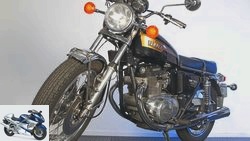
classic
On the move: Yamaha TX 750
A model chronicle of the Yamaha TX 750
read more
The name Bonneville has a record-breaking history
These are more likely to be fulfilled by the English “original”, the classic Bonnie, whose tradition and name go back to the 1950s. The British are known for their tight twins in a light, handy chassis. And since the American Johnny Allen (Triumph fans know the story of course) set a new world speed record with a 650 Triumph engine on the Bonneville Salt Flats in Utah, the British called their 650 model Bonneville, which was presented at the end of 1958. A huge success in the USA, sales in Germany were rather sluggish. Modifications such as the completely new frame (oil-in-frame) with a thick central tube that housed the oil supply for the dry sump lubrication, the five-speed gearbox (1972) and the increase in displacement to initially 724 and then 744 cm³ by enlarging the bore did not help. At the end of 1975 there was still a rear disc brake (for model year 1976), and yet many mourned the old 650 styling, even if they did not want to do without some technical improvements.
For this reason, according to Triumph specialist Dietmar Beck, who got the 750s for comparison (a customer bike he restored) and even made himself available for the photo rides, it is hardly possible to find really original Bonnevilles. Many owners upgrade to the old, round side covers, mount a different rear light, ox-eye flashers or even put their hands on the air filter and carburetor. So our comparison bike is actually a 1979, with rear disc brakes, but those contemporary conversions mentioned that also make a Bonnie a little more individual.
, archive
A picture of a twin: an air-cooled two-cylinder could hardly be styled more classically than the strikingly shaped Triumph 750.
The Triumph cannot and does not want to offer the luxury of an e-starter – it is still honestly male. And this succeeds, after briefly pressing the swab on the 30 Amal carburetors, even the recently spoiled Yamaha switch. Looking for top dead center, a courageous kick, a little gas – the rustic twin reports for service with a robust two-cylinder rumble from the popular, often built-in replica roadster bags.
The clearly long-stroke designed two-valve valve controlled by bumpers and rocker arms is surprisingly willing to turn, but above all impresses with its proverbial punch from the very bottom, in this case from 2500 rpm at the latest. From this speed onwards, the twin delivers a full boom and works if necessary up to the nominal speed of 6500 / min, even if the Bonnie, like the TX, offers a good 5000 tours as shift speed if you don’t have the last reserves, for example with the tight overtaking maneuvers. The mechanical and acoustic expressions of life are always present in a pleasant way, the vibrations are not really unpleasant in any area. Except maybe at a constant 3000 rpm, because our Bonnie sends fine tingling vibrations into the seat in this region.
There are no losers, only winners
So on the Triumph you can only sleep on your bottom, but not your face, you could say, because it never gets boring on the British. The engine tempts you to drive in a sporty, cheeky style, and the extremely slim, graceful-looking and fully fueled Bonnie even more likes winding streets. Especially when the smaller US tank with a capacity of 12.7 liters, which many consider to be nicer, is installed instead of the Europe tank with 18 liters. On the 750er, which is ultra-narrow in the knee area, the knee almost fails, you also want the footrests to be attached a little further back, but with the mounted, wide and comfortably cranked handlebars, the long-legged Englishwoman can be easily thrown into the curve. The gyroscopic forces of the 19-inch front wheel keep the load neatly on the targeted line, only at higher speeds does the 750 appear a bit more stubborn when making quick course corrections.
I am beginning to understand why Steve McQueen once raced around extremely quickly on a 650 Bonnie and in the film “Broken Chains” performed the wildest maneuvers on his TR6 escape machine. At the time, it certainly only seldom braked, but today I can get used to the effect of the front and rear window of the T140, even if you have to grab or pedal hard. It should be mentioned in passing that the fork, like the Yamaha, does not respond well to dry bumps and tends to stumble and both the fork and the Girling struts clearly lack damping. The Triumph is not only fun on country roads, but also in the city, and this is thanks to its great sprinting ability after every stop at traffic lights. The best way to bridge the waiting time is with the clutch pulled, because the search for idling requires a lot of toe-tip feeling when the engine is hot.
The Triumph requires an active driver, but offers a real driving feeling and a pure twin experience. So who is crazy here – the British or the Japanese? In any case, it’s not the Romans today – for once they are not to blame. Another time it will be about Laverda or Ducati Twins. In terms of elegance (Yamaha) and sportiness (Triumph), neither the British nor the Japanese need to fear the Italians. So the opening sentence can be: The spi .., uh, win, the British.
In detail: Triumph Bonneville 750
, archive
The Triumph Bonneville 750.
Facts
The long-stroke engine is considered by Triumph connoisseurs to be robust and, thanks to its relatively simple technology, easy to repair. Complaints like “The bumper tubes are forever leaking” (heat-resistant O-rings help a bit) by some drivers justify the reputation of the Englishwoman as a constantly oil-sapping, vulnerable vehicle, which is not true in practice. In any case, specialist Beck knows a few points that need to be taken into account: “A Bonnie, once properly built, gives peace of mind for a long time and doesn’t really make any complaints. Usually the engine does not have to be opened again until after 60,000 kilometers and possibly overhauled.
Otherwise, there are no more small defects than with other older bikes. ”For example, the heat-stressed alternator cable near the primary drive should be protected against hardening with silicone, and cables that have already become brittle should be replaced. It also makes sense to swap the old, unpotted Lucas ignition (it will wear down) for an electronic one. The MK 1 versions of the Amal carburettors are easier to adjust than the later MK 2, and some convert to the (hardly less powerful) single carburetor version of the otherwise identical Tiger. Chassis and brakes usually give no cause for complaint, you can safely live with the occasional trembling needles and fluctuating display of the clocks in the cockpit. Due to the fluctuating oil consumption depending on the driving style, you should check the oil level of the 750 twin in any case and not use multigrade oil that is too thin.
Buy Triumph Bonneville on markt.motorradonline.de
Used check
, archive
The unit construction version replaced the “pre-unit” in 1963 – the motor and gearbox are no longer separate, but combined in a common housing.
When looking for a Bonneville, it is advisable to take a longer test drive during the tour to test the bike for oil leaks, the carburetor adjustment and the function of the clutch. Frame and engine numbers should be identical if the bike is to be restored, i.e. if money is to be invested. If you are technically savvy, you should check the charging voltage of the alternator with a voltmeter and, if necessary, also check the compression. In case of doubt, it is better to give preference to a bike that is ridden on a regular basis rather than a specimen that has always been dusty in the barn and has a temptingly low mileage. In the years of construction 1976 to 1979 cracks occasionally appeared in the area of the swing arm mounting sleeve on the main frame, which also functions as an oil tank. The result is actually the oil leakage mentioned at the beginning.
market
Many a newcomer to the Triumph lover scene give in to the illusion that a good Bonnie is available for 3,000 or 4,000 euros. For this, there are usually only dumped copies that need immediate repair. It is better to look thoroughly and a little longer for a technically cleanly maintained copy, which is usually only available from 5500 to 6000 euros. Even 7,000 euros are considered absolutely fair for a well-maintained bike. Searching abroad, i.e. England, Italy or France, is hardly worthwhile here, as the offers in Germany are usually still the cheapest.
In detail: Yamaha TX 750
, archive
The Yamaha TX 750.
In order to be able to compete in the popular 750 class, Yamaha had its XS 650 followed by the technically sophisticated TX 750. The parallel twin should run as vibration-free as possible, which is why the omni-phase balancer system, two chain-driven, counter-rotating swing weights were installed. But stretching chains soon led to problems, including engine damage from broken chains. An eccentric clamping device introduced in the first year should help. But the ohc engine was also plagued by heat problems: Because the interference pipe of the manifold was flanged directly to the cylinder head, the lubricant, which was already heavily used, heated up too much, and complaints about slide bearing damage to the crankshaft drive and camshaft increased. Numerous changes, including an oil cooler and an oil pan spacer ring, should ensure calm as a result.
In general, 18 changes were used in the third generation, including tamer camshafts, modified connecting rod bolts, new connecting rods and a new cylinder head gasket. TX of the last year of construction are more durable. Other problem areas not touched by the factory, such as the circuit breaker ignition, can be improved with accessories. The conversion to electronic ignition by Sachse (www.elektronik-sachse.de) was rated positively across the board. Set the rotary selector switch on the ignition box to number three and the TX runs perfectly. Not super cheap at 320 euros, but effective.
Used check
When looking for a TX, it is certainly important to look at the model year and the improvements that have been made. The 1974 models are clearly preferable to treating early models with caution, for example without a retrofitted oil cooler. The best thing to do is to ask a TX specialist from the IG anyway, and watch out for noises during the inspection that indicate a beating, untensioned balancer chain. Otherwise, it is important to pay attention to the condition of the paint parts, the paint is often faded, especially the renewal of the paint in Metalflake Gold is time-consuming and not cheap. The exhaust system also requires critical consideration, original parts are practically no longer available, but replicas are now available. In general, those who are moderately versed in mechanics should consider a freshly revised, more expensive specimen, as the elaborately designed engine poses a certain challenge.
market
Of the few copies sold in Germany anyway (1973: 700, 1974: around 600, a few remaining copies in 1975), most of the still existing ones are in the hands of enthusiasts. If a TX is offered, ailing craft stalls barely cost 1000 euros, but well-maintained vehicles cost between 3500 and 6000 euros. As is so often the case, it is also worth taking a look beyond the borders here, because the number of vehicles in this country is only in double digits.
Related articles
-
Kawasaki Z 750 B, Triumph Bonneville 750 and Yamaha XS 650
bilski-fotografie.de 31 pictures bilski-fotografie.de 1/31 On the move with the Kawasaki Z 750 B, Triumph Bonneville 750 and the Yamaha XS 650 ….
-
Triumph Street Twin and Triumph Bonneville T100 in comparison
26 pictures 1/26 Power on the crankshaft. Measurements on the Dynojet roller test stand 250, corrected according to 95/1 / EG, maximum possible …
-
On the move with Kawasaki GPZ 900 R and Yamaha FJ 1100
fact 39 photos fact 1/39 Hurry with a while, always slowly with the young horses – sayings like these were definitely not up for debate when the new,…
-
Cathcart Finale: triumph and the speed record 50 years of Triumph Bonneville It is true that the legendary speed records were 54 years ago, but it has…
-
On the road with the BMW K 75, Triumph Trident T150 and Yamaha XS 750
fact 34 photos www.factstudio.de 1/34 Picture gallery, On the move: BMW K 75, Triumph Trident T150, Yamaha XS 750. www.factstudio.de 2/34 If you are into…
-
Comparison test: Honda CB 1000 R, Yamaha FZ1, Triumph Speed Triple, Kawasaki Z 1000
Comparison test: Honda CB 1000 R, Yamaha FZ1, Triumph Speed Triple, Kawasaki Z 1000 Large naked bikes in comparison Contents of …
-
Yamaha MT-09 Tracer, MV Agusta Stradale 800 and Triumph Tiger 800 XRx
fact 22 pictures fact 1/22 MV Agusta Stradale 800, Triumph Tiger 800 XRx and Yamaha MT-09 Tracer in a comparison test. fact 2/22 One for all: …
-
Driving report Triumph Thruxton R and Triumph Bonneville T120
triumph 20th photos triumph 1/20 The Thruxton has become a fine, classy cafe racer. triumph 2/20 Triumph Thruxton R triumph 3/20 Anyone looking for…
-
35 pictures 1/35 picture gallery: Triumph Bonneville T100 Black, Moto Guzzi V9 Roamer and Harley-Davidson Sportster 883 Iron in …
-
Triumph Bonneville 750 T140 J Silver Jubilee
r-photography.info 21 pictures Rossen Gargolov 1/21 Triumph celebrated the 25th anniversary of Queen Elizabeth II’s throne in 1977 with a special model. I agree…